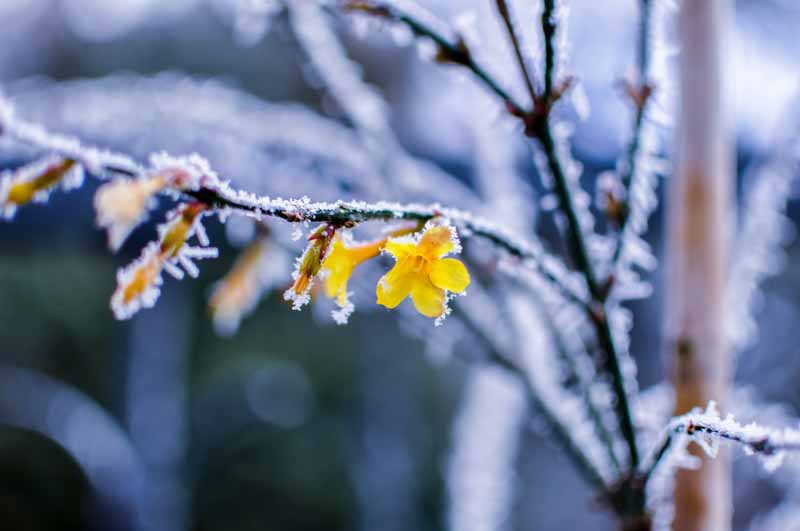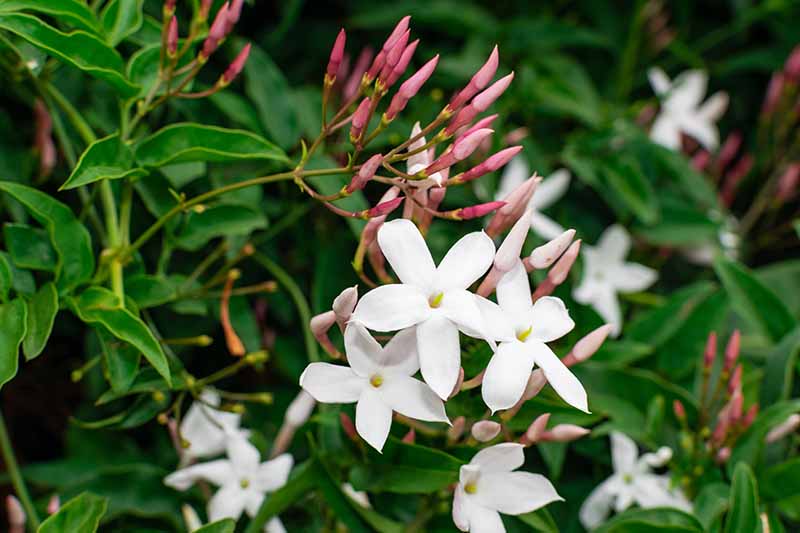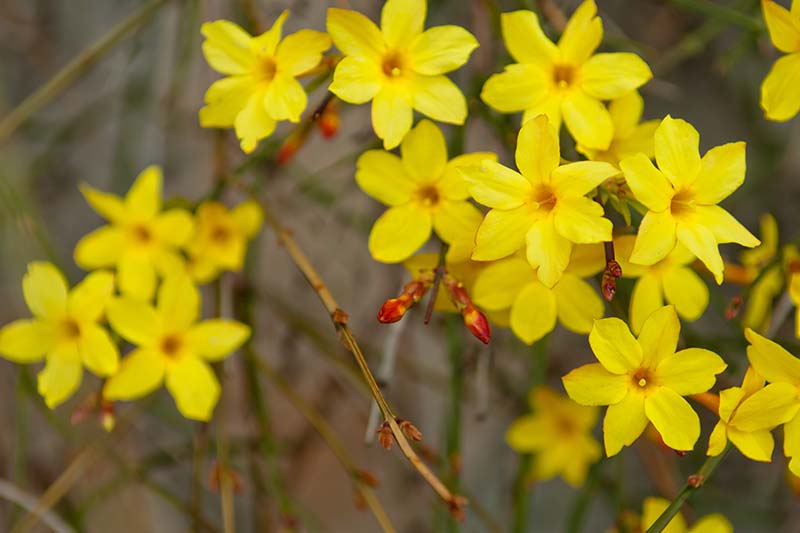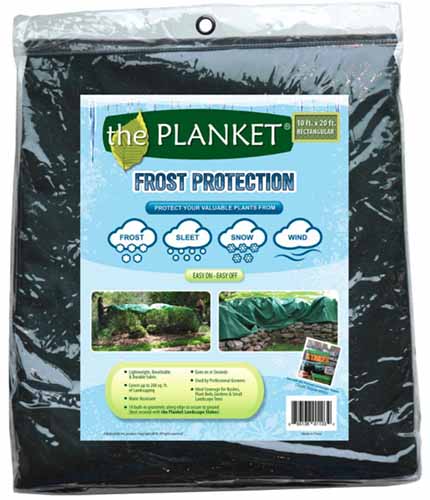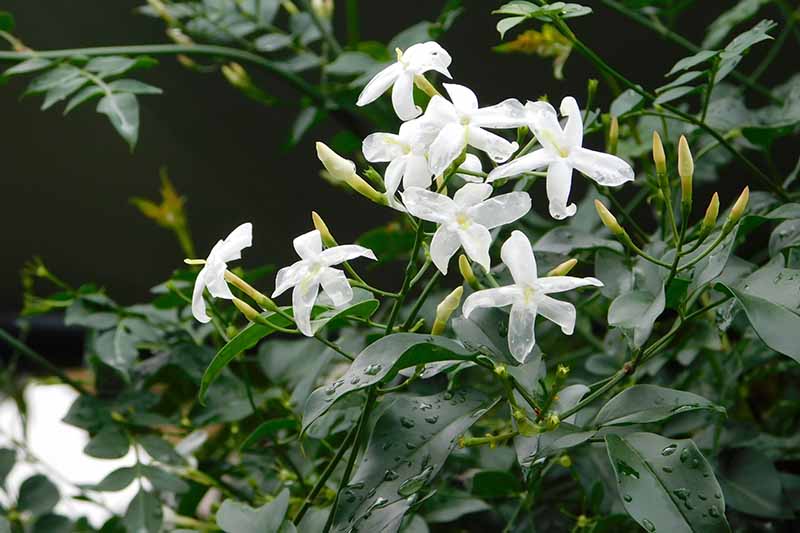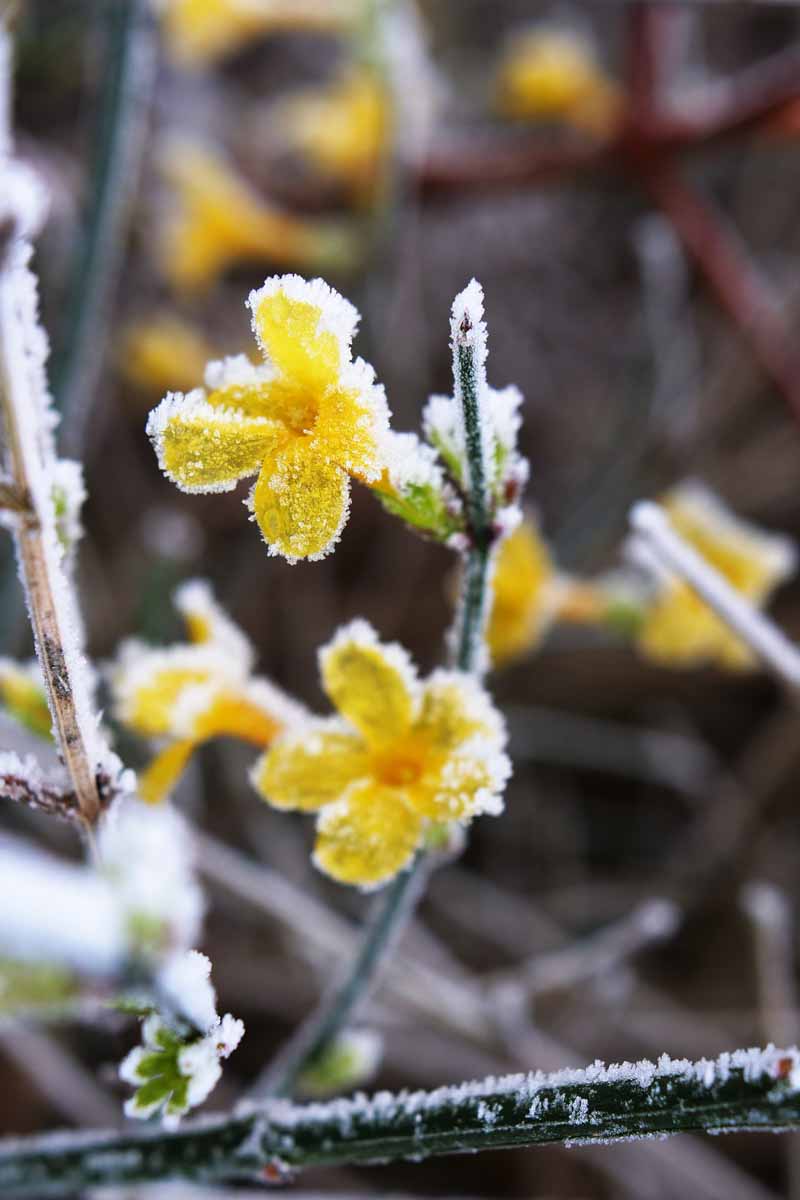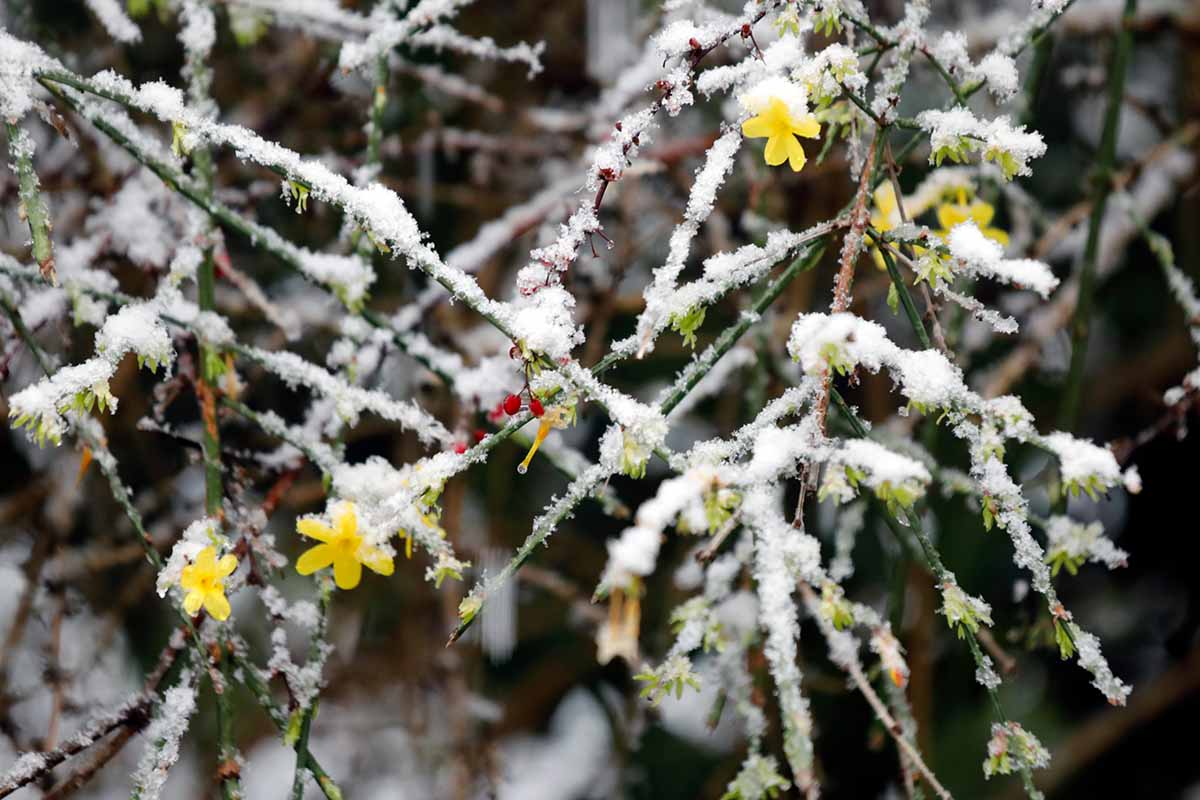Even though most species of this semi-climbing perennial are best suited for tropical and subtropical climes, some, such as true jasmine (Jasminum officinale), can not only tolerate colder temperatures, but may in fact require one to two months of chilling to bloom, or for seeds to germinate. We link to vendors to help you find relevant products. If you buy from one of our links, we may earn a commission. Perhaps the intoxicating scent is reason enough to make it worthwhile. So, how do you protect your jasmine from those harsh winter conditions? Here’s everything we’ll cover up ahead:
Suitable Growing Regions and Suggested Cultivars
In areas with lower seasonal temperatures, blooms can open from spring to late fall. Some varieties may even bloom in winter. It’s in the regions where fall signals the dormancy of most plants and gives way to cold, dry air and frozen precipitation that jasmine may need protection, and in some cases, will need to be brought indoors entirely. Most, but not all, varieties of jasmine are hardy to USDA Hardiness Zone 7. Which varieties are hardiest and suitable for regions that experience seasonal frost, snow, or hard freezes? Let’s take a look.
True Jasmine
J. officinale, also known as hardy or true jasmine, is one of the most popular deciduous types in cultivation. Its cold tolerance makes it an excellent choice for Zones 7 to 11, and it can sometimes withstand the low temperatures of Zone 6 with adequate protection. With enough exposure to chilly temperatures, its blooms can actually be improved for the next season.
Winter Jasmine
J. nudiflorum, the winter variety, is cold tolerant down to Zone 6, where low temperatures in winter average -5 to 10°F, and it can also thrive in warmer climates up to Zone 9. In some cases, this species can potentially bloom even in snow. Unfortunately, winter jasmine is less fragrant than other types, but you’re trading some of the scent for winter blooms – which seems fair, doesn’t it? You can read more about growing this variety here. Other species may require extra special care, or may not be suitable for growing year-round in cooler zones. If you’re prepared to provide more protection or bring plants indoors, it’ll open up more options for growing different varieties. So, let’s discuss how to protect your plant through the winter.
Outdoor Winterizing Tips
First and foremost, choose a variety suited to your region if you intend to leave it outdoors throughout the winter, where it can be protected with a layer of mulch prior to the onset of cold temperatures. Mulch can be made of shredded hardwood, straw, or fallen leaves. Leaves should be shredded into about one-inch pieces prior to spreading. Plants should be watered deeply prior to mulching. Wood mulch should be spread about three inches deep at the base of the plant, prior to the first predicted frost. Straw or shredded leaf mulch can be spread up to six inches deep. It can sometimes harbor excess moisture and create conditions that cause mildew or mold to grow where it comes in contact with plant material. Frost cloth is a good option for covering jasmine vines, and is available in a variety of sizes and configurations, such as this 10-by-20-foot rectangle from the Home Depot. The Planket Frost Cloth Any time when you choose to wrap vines with cloth, you’ll want to make sure the material allows light to filter through, and avoid clipping or tying the cloth directly to your plants. In instances where snow or high winds occur, cloth can add weight on top of or pull against the plant and cause damage. If damage from heavy snow is a concern, consider using fabric tree wraps instead. This fabric can be wrapped more closely around the plant, without creating a flat surface at the top where snow can collect. Dalen Tree Wrap Bubble wrap is another option for wrapping plants for the winter, but use this material with caution. If you pick a species or variety that is not able to tolerate the average low winter temperatures and weather conditions in your area, you will most likely need to plant it in a container so you can bring it indoors.
Moving Jasmine Indoors for the Winter
Overwintering indoors comes with some challenges that require more attention and work. Typically, most varieties of jasmine set buds in late summer through fall in preparation for spring blooming. They need a cool period, with a temperature difference from day to night of about 15 degrees. Temperatures ranging from 60 to 75°F in the daytime and 40 to 60°F in the evening are ideal to trigger budding, so it’s best to wait to move them indoors for as long as possible while temperatures remain in this range. When daily low temperatures begin to drop between 40 and 50°F, you’ll want to prepare to bring your potted jasmine plants indoors, as this is the lower end of the range that most types can safely tolerate. Be sure to allow at least 30 days before the first average frost date as well, as you make your preparations. First, check to make sure any pests aren’t hitching a ride, such as mealybugs and aphids that may remain on leaves, stems, and blooms. You don’t want to bring them indoors. Begin by bringing the plant inside for a few hours at a time to allow it to acclimate to the indoors gradually. Avoid bringing it in permanently without giving it time to adjust first as this can shock the plant, which can result in death. Gradually increase the length of indoor time until it’s fully acclimated to the indoor temperature and lighting conditions. Even indoors, vining types will still need support, so a lightweight trellis or structure that can be moved along with the potted plant is necessary. It’s also best to avoid pruning prior to bringing the plant indoors, as you’ll be trimming off buds. Next, decide where you’ll place the plant for its long-term winter residency. Jasmine prefers partial shade, and in the winter months, you’ll still want to keep it away from full, direct sunlight. A location in proximity to a sunny window, but not directly in front of it, is perfect. An average room temperature of about 60 to 72°F is suitable for the daytime hours, but you’ll want to provide cooler temperatures in the 50 to 60°F range in the evening if possible. Medium to low light and cooler temperatures can better mimic natural outdoor winter conditions while avoiding the unsafe chill, to allow the plant to conserve energy. Start from the ground and work your way up, confirming that conditions are appropriate – the container is the appropriate size; it’s receiving adequate water, humidity, and sun exposure; temperatures are warm during the day and cooler at night; and there are no signs of pests or disease. Digital Hygrometer Rooms in your home where water is present – such as the kitchen, bathroom, or laundry areas – are best, as some humidity will naturally remain in the air in these places. You’ll most likely need to add a cool-mist humidifier or mist the plant by hand daily. If you’re not sure which humidifier to go with, this one that’s available from Walmart is inexpensive, cute, and functional. Indoor Humidifier Be sure to keep the soil slightly moist, but not wet. Jasmine needs adequate water but does not tolerate soggy soil. You may only need to water it once every one to two weeks, as long as it’s not drying out too fast. If your plant begins to show signs of stress or poor health such as discoloration, or leaf or bud drop, you can run through a short checklist to make sure it’s getting what it needs: If you note any issues, remediate them as needed. As the winter begins to wrap up and the forecast starts looking more spring-like, you can prepare your plant for its return to the outdoors. Begin by exposing it to more direct sunlight for a few hours per day, and provide a little more water. After the danger of frost has passed and temperatures start climbing back into the low 60s, it’s a good time to move the plant outdoors for a few hours at a time to reacclimate it to outdoor conditions. Each time you move it outdoors, leave it there for a longer period until it’s comfortably adjusted and able to stay outdoors full-time. Be sure to pay attention to overnight low temperatures, as these can still dip below the plant’s tolerance during cold snaps at this time of year. If the local weather forecast indicates that evening or overnight temperatures will fall below about 40°F, it’s best to bring the plant indoors for that time. To keep your jasmine growing and healthy after a period of indoor slumber, you can add some fertilizer for a spring boost. A 7-9-5 (NPK) blend will provide what your plant needs for both blooms and foliage.
Aside from winter care, growing jasmine is actually very simple and highly rewarding. We hope you agree! Do you have jasmine growing in your garden? We’d love to see pictures of yours in the comments below! Feel free to share any questions you may have as well. If you’ve decided that overwintering a jasmine plant is just too much work for you, consider reading up on other flowering vines that are more cold hardy, such as these:
The Complete Clematis Growing GuideHow to Grow Fragrant, Colorful HoneysuckleHow to Grow and Care for Passionflower

